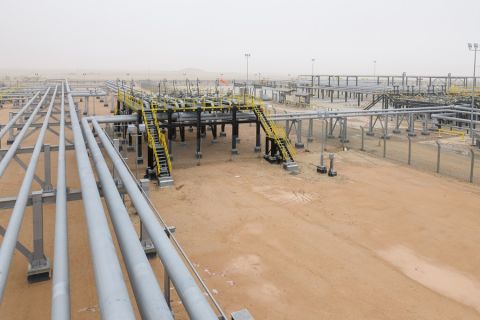
A mega-deal with Pioneer could cost Exxon $70 billion including the assumption of about $4 billion in net debt. (Source: Shutterstock)
As many public E&Ps search for runway in U.S. shale basins, analysts say Exxon Mobil Corp. could boost its Permian Basin inventory through a deal with Pioneer Natural Resources.
Exxon Mobil has reportedly held discussions on potential M&A with Permian pure-player Pioneer, which is focused in the Midland Basin. However, talks between the two oil and gas companies are preliminary and a deal would likely not materialize for several months, according to media reports.
Exxon and Pioneer, in separate emails, told Hart Energy they would not comment on market rumors or speculation.
But Exxon does have interest in growing its already sizable position in the Permian, the Lower 48’s premier shale basin.
As commodity prices rose emerging from the COVID-19 pandemic, Exxon started to clear its DUC inventory in the Permian by bringing those wells into production, CEO Darren Woods said in the company’s fourth-quarter conference call.
Heading into this year, Exxon was focused on rebuilding that inventory to maintain its production runway for the next several years, Woods said.
Several public E&Ps sought to boost their Permian inventory through M&A with smaller operators recently. Last week, Ovintiv Inc. agreed to scoop up three EnCap-backed privates – Black Swan Oil & Gas, PetroLegacy Energy and Piedra Resources – in the Northern Midland Basin in a cash-and-stock deal valued at $4.725 billion.
Within the past year, Matador Resources and Diamondback Energy also signed $1 billion-plus deals to acquire private E&Ps in the Permian.
With much of the basin’s core acreage picked through and private E&Ps operating in more fringe areas of the play, it’s becoming increasingly competitive for publics to acquire core drilling inventory in the Permian.
RELATED
Analysts: Shale M&A Opportunities Shrink After Ovintiv’s $4.2 Billion Permian Deal
Pioneer and several other independent E&Ps could be acquisition targets in the coming quarters given the desire for larger operators and supermajors, like Exxon, to grow their inventories, analysts for Truist Securities said.
“We anticipate the Permian to remain the hottest region given many existing companies desire to beef up their positions along with several public and/or private operators potentially deciding to monetize their positions,” analysts at Truist Securities wrote in an April 10 research note.
Other high-quality independent shale E&Ps, including Hess Corp., EOG Resources, ConocoPhillips, Apache Corp. and Devon Energy could be other potential M&A targets for supermajors, researchers at Sanford C. Bernstein said late last year.
With its war chests bursting with cash from outsized profits in the last year, Exxon could materially boost its runway in the core of the Midland Basin through a huge deal with Pioneer, analysts say. What a megadeal with Pioneer could cost Exxon remains a key question for investors.
Making a megadeal
A long-term takeout by Exxon has always been seen as a reasonable end-game scenario for Pioneer, given the company’s low-cost single-basin profile and one of the largest independent E&P production profiles, analysts at TD Cowen said.
Pioneer’s oil production in the Midland Basin averaged 352,000 barrels per day (bbl/d) during 2022, according to company regulatory filings; Total 2022 production averaged 650,000 barrels of oil equivalent per day (boe/d).
Pioneer ended last year with proved undeveloped reserves and proved developed non-producing reserves of 120 million barrels (MMbbl) of oil, 86 MMbbl of NGL and 463 billion cubic feet of natural gas, according to the company’s regulatory filings.
As of the end of last year, Pioneer held 856,000 total net acres, including 844,000 located in the Spraberry/Wolfcamp plays in the Midland Basin.

Exxon expects its Permian net production to reach more than 600,000 boe/d this year, and the company plans to boost production in the basin up to 1 MMboe/d by 2027.
Pioneer has a market cap of nearly $52 billion, with the company’s stock up over 5% at $220 per share in morning trading on April 10, according to data from Yahoo Finance.
In order to attract a deal with Pioneer, Exxon would need to offer about $280 per share, according to TD Cowen – a 20% discount to Pioneer’s net asset value and a roughly 35% premium compared to the company’s closing share price on April 6, when the talks were first reported.
A mega-deal with Pioneer could cost Exxon $70 billion including the assumption of about $4 billion in net debt.
“Exxon has $30 billion cash and capacity to take on additional debt, though [the company] would breach its [debt-to-capital] target without issuing equity for the deal,” analysts at TD Cowen wrote in an April 10 research note.
RELATED
Public, Private E&Ps Split on Permian Basin Drilling Strategies
Recommended Reading
Shipping Industry Urges UN to Protect Vessels After Iran Seizure
2024-04-19 - Merchant ships and seafarers are increasingly in peril at sea as attacks escalate in the Middle East.
Paisie: Crude Prices Rising Faster Than Expected
2024-04-19 - Supply cuts by OPEC+, tensions in Ukraine and Gaza drive the increases.
Report: Freeport LNG Hits Sixth Day of Dwindling Gas Consumption
2024-04-17 - With Freeport LNG operating at a fraction of its full capacity, natural gas futures have fallen following a short rally the week before.
Permian NatGas Hits 15-month Low as Negative Prices Linger
2024-04-16 - Prices at the Waha Hub in West Texas closed at negative $2.99/MMBtu on April 15, its lowest since December 2022.
BP Starts Oil Production at New Offshore Platform in Azerbaijan
2024-04-16 - Azeri Central East offshore platform is the seventh oil platform installed in the Azeri-Chirag-Gunashli field in the Caspian Sea.


